|
Find interviews by: | ||
The Blackout Director: Robert David Sanders
The story takes place on Christmas Eve, making this one of a select number of pictures which take place at Christmas without actually being Christmas movies. Gremlins is another famous example. A TV newsreader infodump tells us that Los Angeles is suffering from an unseasonal heatwave, frequent power outages and numerous earth tremors - all with different epicentres - that have already cracked freeways and swallowed up half a shopping mall. Despite this, the stock footage shows Losangelenos carrying on as normal and there is no suggestion that the National Guard has been called in or that there has been panic or evacuation or any of the things you would expect if significant seismic activity was detected in the vicinity of the San Andreas fault. The apartment block is largely empty, we are told, because everyone has gone home for the holidays. I think people are just using that as excuse because who would be dumb enough to stay in a multi-storey tower block on a major seismic faultline that’s overdue for a quake as minor tremors proliferate to the extent of actually damaging buildings? In one apartment are the Pierce family: dad Daniel (Joseph Dunn, who was in a stage revival of Beyond the Fringe), mum Elizabeth (producer Barbara Streifel Sanders: Creature of Habit) and kids Kyle (Tyler Armstrong) and Ashley (Abigail Droeger: Bedtime Stories) who are both about 10 or 11. Plus Daniel’s brother Dylan (Ian Malcolm). Elizabeth doesn’t want Dylan there but it’s not clear where her animosity comes from apart from a slight selfishness on his part, which rapidly disappears once the plot kicks in. Next door the glamorous Sophie St James (Ashby Plain) is throwing a Christmas party with guests including lovey-dovey couple Brett Carlisle (John Gorman: Frost: Portrait of a Vampire, Boston Strangler: The Untold Story) and Kerri Sterling (Alexis Zibolis: Plaguers, The Asylum’s The Da Vinci Treasure and ‘hot dead chick’ in a short called LA Vampire) who really should just get a room. Distinctly less lovey-dovey are Ethan and Claire Devane (associate producer Michael Caruso and Caroline Rich: Kung Fu Man) who have just begun divorce proceedings, leading hostess Sophie to believe that Ethan is now available. Eddie Clifton (former cop/soldier James Martinez) is a professional bodyguard - and looks it - who brings with him to the party his distinctly less heavyweight colleague Lenny Louis (the very cooly named Ace Gibson: Room 33, Scream Machine and an episode of The Sarah Connor Chronicles) who has the hots for Sophie but is rebuffed. There are other people at the party but they have no names or lines and will die before too long. The ‘super’ is a bluff, no-nonsense bloke named Nigel Crawford, played by Horace Martin with a weird Britoid accent that is possibly supposed to be Australian. He is accompanied by an electrician named Ralph (Native American stand-up comic Larry Omaha) whose lack of a surname suggests he won’t be long for this world, although he has a forename and some lines so will probably survive longer than the uncredited party guests.
Freddy isn’t at the party because he is agoraphobic and hasn’t left his apartment in six years (presumably all his food, toiletries etc are delivered). This becomes vaguely relevant later on when there’s some talk of people going up onto the roof to escape the monster but Freddy’s agoraphobia almost immediately disappears. More interesting is that he is an amateur radio ham, sitting at a desk surrounded by big, clunky equipment. Wait a minute - an amateur radio ham? How long ago was this script written? I mean, my brother was a radio ham in the 1980s and it was old-fashioned then. I’m sure there’s still a few people out there who are nuts about valves but you know, it use used to be a way to keep in touch with people across the globe. And now we have this little thing called the internet... When the building is hit by a power outage - the blackout of the title - for some reason Freddy’s radio equipment is unaffected and his lights stay on too, although they are (inexplicably) submarine-style red lamps. I don’t know why Freddy might need to keep his eyes adjusted to night vision if he never leaves the apartment but I’m more concerned with his power source. Does he have large amounts of heavy batteries delivered along with his food? The audience’s natural expectation is that Freddy’s radio equipment will become relevant, especially as the power outage has also somehow disabled everyone’s mobile phones. It’s not just that the local phone mast is dead, there’s actually a sharp noise simultaneously from every mobile at the party. This leaves Freddy - with his microphone, valves and independent power source as potentially the only way of contacting the outside world and finding out what is going on. Or indeed, trying to call for help. But once the Pierces and the folk from the party meet up with Freddy and Horace, his radio equipment is forgotten (not that it has been majorly discussed before then). The whole thing reeks of a subplot which has been excised from the final draft of the script but not removed completely. Freddy also mentions that his family owns the building, which proves to be even more irrelevant than his radio ham hobby. “But you know that,” he says to building supervisor Horace as a small flashing caption appears on screen reading ‘infodump!’, which is rather startling. No, I’m lying of course. But the caption might as well be there as it’s one of the least subtle mini-infodumps I’ve ever seen, made all the more unnecessary because it’s about an irrelevant fact which is never alluded to again. So anyway, what’s happening with the PIerce family? Ashley has been a good girl and cleared the dinner table so Kyle, for not helping his sister, is sent all the way down to the basement to fetch a box which has a large Christmas present inside it. And down in the basement he finds... things. Large scuttling things which are possibly supposed to look like weird mini-monsters but actually look exactly like horseshoe crabs, only a sort of silver colour.
I’ve got to give this film props for starting off its action by killing a kid - and not a naughty kid either. This is about 18 minutes in and not a moment too soon as the film has been dragging a bit up to now while it establishes its characters and their (rather perfunctory) relationships. It is after this that the lights go out and Daniel Pierce decides to go down to the basement and find his son who would be, presumably, screaming in the darkness even if there were no monsters (or horseshoe crabs). Oddly Pierce, seems quite laconic about retrieving his little boy. I mean, the Pierces’ apartment has some basic light from a fortuitous full moon shining through the windows, but little Kyle in the basement will be in stygian darkness, feeling his way blindly around unfamiliar walls as he desperately tries to find the (non-functioning) lift. Or he would be, if something hadn’t eaten him. Ashley wants to go with her father and, when her mother’s initial, half-hearted protests are over-ruled, she jumps up for a piggy back. I know it’s Christmas Eve and you’re a happy family (brother-in-law Dylan notwithstanding) but show a bit of urgency, folks. There’s a child in terror down there. As far as you know. Daniel calls the lift which is, for some reason, still working despite the power outage. He tells Ashley to stay put while he sidles down the dark corridor, trying to locate the source of a noise. The lift arrives and Ashley, without a word, while her Dad’s back is turned, steps in and presses the down button. Which is convenient for the plot and all but completely and utterly inconsistent with both the situation and her character as demonstrated up to that point. So now both of Daniel’s children are alone in the dark, underground depths of a huge, almost entirely empty building with no lights. And he only seems mildly put out by this. So does he press the lift button and wait for it to come back up again so he can follow his daughter and find his son? Does he take the stairs down the basement (it’s only five flights and it’s down - perfectly manageable for a fit adult). No. In fact, he goes back to his flat to tell his wife. Who seems equally lacklustre in her concern. Meanwhile, next door the party is interrupted by a barely glimpsed monstrous beast which jumps out of the shadows and kills someone, sending the guests into a panic. Everyone who has a character name makes it out of the door with Eddie Clifton proving to have a surprisingly clunky automatic pistol on hand. The partygoers hammer on the door of the next flat along, which by great good fortune is the Pierces’, and are eventually let in. Huge apartment building with only three occupied flats, and one of them is next door. That’s blooming handy. Now we get some powerful character conflict as Mr and Mrs Pierce want to go downstairs and rescue their children (at last) while the partygoers, led by gun-toting Eddie, refuse to open the door in case that thing is outside. Until eventually, they decide that they will. Everyone piles out and heads downstairs, meeting Freddy and Horace along the way (Ralph the electrician having bought it by this point).
The monsters themselves are relatively novel; albeit they can be positioned on the GMQ - the Generic Monster Quadrant. This is a hypothetical graph, with both positive and negative axes in both directions, which represents the respective proportions of the four movie monsters on which 99% of all other movie monsters are based. That’s Alien, Predator, Pumpkinhead and Xtro. Hence it is sometimes called the APPX graph. I am, of course, making up most of this bollocks as I type. The unnamed Blackout monsters sit in the A part of this graph, being animalistic in behaviour, fast-moving, powerful, black and shiny with a long tail and (on the poster at least) far too many teeth. The humanoid body is simply a performer in a costume but the prehensile (CGI) tail has, as a nice, original touch, a razor sharp pincer at the end which is capable of slicing off a victim’s (CGI) head. (A full-size prop tail was made for the film but not used as it was too cumbersome.) It’s a commendably long time before we get a good look at a monster and even then fast editing and skilful lighting restrict our view and thereby boost the horror quotient. But we do eventually see enough to realise that the monsters don’t actually look anything like the one on this US poster with its puppet-head, scabby skin, vestigial wattle, large ocular cavity and craniodorsal quills. Nor do the monsters look like the completely different one on the UK DVD with its scaly mouthparts, dripping saliva and almost random dentition. It’s quite impressive to have two different official publicity designs actually revealing your monster and not have either of them showing the actual beast in question. Frankly, what we see of the creature’s head most closely resembles Syngenor, only without the cranial crest. The poster images, even with their severe cropping, want to give the impression that this is some sort of Giger-esque, mocking distortion of human morphology whereas in fact it’s a person in a close-fitting black suit with (as far as I can determine) extensive but straight dentition. And a CGI pincer-tail.
Ashley is eventually discovered hiding in the lift but this has somehow reached the top of the lift-shaft. Look, are these lifts working or not? As a last-act kicker, the survivors find enormous stone spikes pushing up from the ground like some sort of sharpened version of The Monolith Monsters. No explanation is ever offered for the monsters or the spikes - or indeed the crabs - except that they have come out of the ground and must therefore be connected in some way with the multiple epicentre tremors which, we are told more than once, have completely baffled Caltech. I honestly don’t mind a lack of explanation; many great monster films don’t bother with it. Whether the monsters (or spikes) directly caused the power outages isn’t clear either and that could have been explored a bit more. Nerdy radio ham Freddy deduces that the creatures are surrounded by some sort of electromagnetic field which causes people’s torches to flicker and fail when a monster approaches. Now this is actually a pretty neat (if somewhat daft) idea. A few people do have torches - or ‘flashlights’ as the colonials call them - but they have this propensity to stop working just when needed the most, which seemed initially to be pure dramatic convenience so I was pleased to see an explanation offered. What would have been even better would have been to have other battery-operated devices that failed at crucial moments just before an attack. Imagine if one of the characters had been hearing-impaired and reliant on a hearing aid. Which fails, just as their comrades start yelling at them to get the hell out of there. That would have been a neat variation on the theme. But of course this is cinematic Los Angeles and we all know that there are no disabled people in Hollywood movies, not even deaf ones. In this fictional city, the closest anyone gets to an actual disability is to be like Freddy: slightly overweight. With a beard. There is also a theory advanced at one point that shining a torch directly at a creature will disorientate it because these things operate in the dark so they absolutely must be photosensitive. What, in the way that owls and bats and hedgehogs are photosensitive? Fortunately, this idea is swiftly forgotten, which suggests it may be another vestigial subplot that hasn’t been completely removed. There is also the question of the unseasonal heatwave, as infodumped to us at the start. We may surmise that this is also the monsters’/spikes’ doing but we may do no more than that and it is, like so much else, irrelevant. The Blackout is a fun movie with plenty of shocks and scares (once it gets going) and reasonably interesting characters that we do at least care about. We don’t know who will die next and we’re upset when they do. Its two biggest flaws are the number of unformed subplots left dangling and, it must be said, the sadly unbelievable characters of Daniel and Elizabeth Pierce. These two just don’t come across like real parents. At all.
There is only one thing worse than a child being killed, and that is a child facing imminent death, screaming pathetically for its parents to come to the rescue and receiving no answer. That’s the worst thing in the world and if Mr and Mrs Pierce don’t agree then they are cardboard cut-outs, not the rounded characters that the film-makers intended. The film was shot in the studio and on location for four weeks from the end of July 2007 with pick-ups in December to get establishing shots of the city, the TV newsreader and a few effects sequences. It all looks very slick and professional with good quality camera-work, editing and sound. Mark W Ross was the cinematographer with the unenviable job of lighting a film which is supposed to mostly take place in darkness. Unavoidably, this means that most shots are actually remarkably well-lit for their location, because a realistic lighting level would mean we couldn’t actually see anything. The motive force behind the film are Robert and Barbara Sanders, respectively director/co-writer/editor and producer/actress, who together comprise Starway Productions. Cinematographer Ross and writer Jim Beck (who gets solo credit on the IMDB) are frequent collaborators with Mr and Mrs Sanders, having worked on various shorts. The Starway team actually shot a previous feature way back in 1998, The Dead, which remains unreleased because - apparently - its design is too similar to The Matrix and its plot is too similar to Kill Bill Vol.1. That sounds awfully suspicious to me. Since when have indie film-makers declined to release their own work because a studio blockbuster has come out which resembles it in some way? That’s normally a good excuse to get straight down to the AFM or Cannes and flog the movie you’ve made to distributors hungry to cash in on the latest cinematic trend. No, there’s got to be more to it than that. There are two ‘chapters’ of The Dead on the Starway site, totalling about 27 minutes. Interestingly, this also features a city-wide blackout. Other Starway productions include an Iraqi War short Day 11, a sci-fi short Expired and a comedy about a fast food mascot, Fetwick. They’re developing a horror feature Shadow Point (aka Shadow Falls) and The Twenty-Third Letter, a sci-fi picture about telekinesis. So The Blackout is Starway’s first properly released feature film and it’s a credible debut. It won’t set the world alight but it also doesn’t disappoint and indicates a commitment to quality genre films. MJS rating: B | ||

 Robert David Sanders’
Robert David Sanders’ 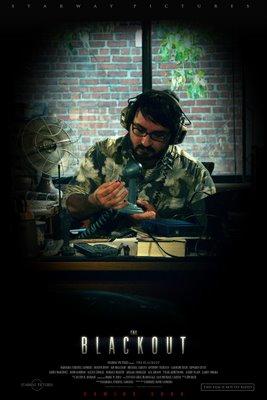 Finally there is tubby, bearded Freddy Appleton (Freddy Tedesco, who was in a vampire short called
Finally there is tubby, bearded Freddy Appleton (Freddy Tedesco, who was in a vampire short called 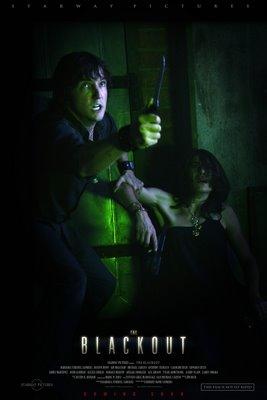 I wouldn’t expect an eleven-year-old boy to wonder “What are these horseshoe crabs doing in the basement of an LA apartment building?” but the audience will certainly think that. The thing is, it’s not the crabs that Kyle needs to worry about. It’s whatever is eating them and rolling their bloody carapaces along the floor towards him.
I wouldn’t expect an eleven-year-old boy to wonder “What are these horseshoe crabs doing in the basement of an LA apartment building?” but the audience will certainly think that. The thing is, it’s not the crabs that Kyle needs to worry about. It’s whatever is eating them and rolling their bloody carapaces along the floor towards him.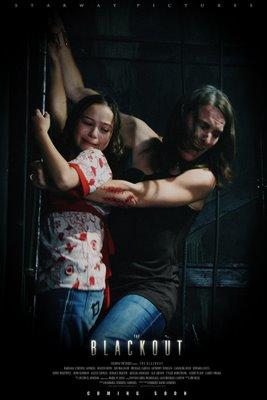 That’s really the plot, as far as an actual story goes, and for the rest of the film it’s a question of who will be next to die. Here is where the film comes into its own, with good direction, some really scary moments and use of spooky atmosphere and tension in place of easy cat-scares. My favourite is when a monster attacks a couple from a position on the ceiling and, as the woman is dragged upwards, her struggling feet repeatedly kick the guy in the face. This could easily have been played for laughs but it’s actually quite dramatic; her terrified thrashing about impedes his attempted rescue. Clever, original and upsetting - more like this please.
That’s really the plot, as far as an actual story goes, and for the rest of the film it’s a question of who will be next to die. Here is where the film comes into its own, with good direction, some really scary moments and use of spooky atmosphere and tension in place of easy cat-scares. My favourite is when a monster attacks a couple from a position on the ceiling and, as the woman is dragged upwards, her struggling feet repeatedly kick the guy in the face. This could easily have been played for laughs but it’s actually quite dramatic; her terrified thrashing about impedes his attempted rescue. Clever, original and upsetting - more like this please.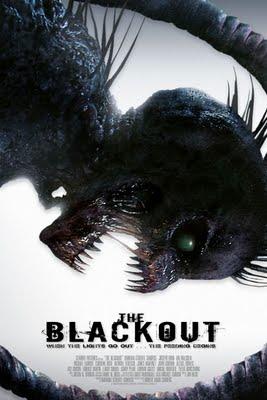 Anyway, the point is that the creatures are fast, strong, deadly animals, capable of eviscerating a human as easily as they did the horseshoe crabs in the basement. Our dwindling gang of survivors do eventually make it down to the basement where they immediately deduce (a) that the horseshoe crabs are the creatures’ food supply and (b) that a solitary shoe means that Kyle is dead. (Which he is, but they don’t know that.)
Anyway, the point is that the creatures are fast, strong, deadly animals, capable of eviscerating a human as easily as they did the horseshoe crabs in the basement. Our dwindling gang of survivors do eventually make it down to the basement where they immediately deduce (a) that the horseshoe crabs are the creatures’ food supply and (b) that a solitary shoe means that Kyle is dead. (Which he is, but they don’t know that.)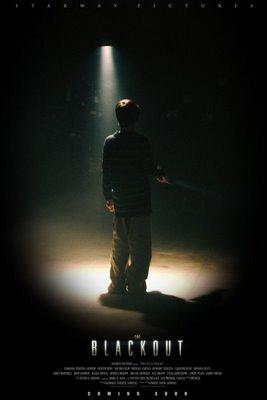 Listen, I’m a parent. And if I thought that young TF was alone, scared and in mortal danger, I would move Heaven and bloody Earth to get to him. And any responsible parent would do the same. Dan and Liz Pierce’s lack of concern at first their son’s peril and subsequently his sister’s just doesn’t ring true for one moment. Even once they become aware that there are deadly monsters in the building, the rescue of their children is just a part of a greater plan to get everyone out of the place. When Eddie Clifton threatens them with his gun to stop them opening the apartment door, it’s actually brother-in-law Dylan who tries, bravely but unsuccessfully to wrest control of the situation. Kyle and Ashley’s parents should be frantic. Whether panicking hysterically or frighteningly calm and collected, I just can’t believe that either would be bothered about anything at all except getting down to that basement as fast as humanly possible.
Listen, I’m a parent. And if I thought that young TF was alone, scared and in mortal danger, I would move Heaven and bloody Earth to get to him. And any responsible parent would do the same. Dan and Liz Pierce’s lack of concern at first their son’s peril and subsequently his sister’s just doesn’t ring true for one moment. Even once they become aware that there are deadly monsters in the building, the rescue of their children is just a part of a greater plan to get everyone out of the place. When Eddie Clifton threatens them with his gun to stop them opening the apartment door, it’s actually brother-in-law Dylan who tries, bravely but unsuccessfully to wrest control of the situation. Kyle and Ashley’s parents should be frantic. Whether panicking hysterically or frighteningly calm and collected, I just can’t believe that either would be bothered about anything at all except getting down to that basement as fast as humanly possible.